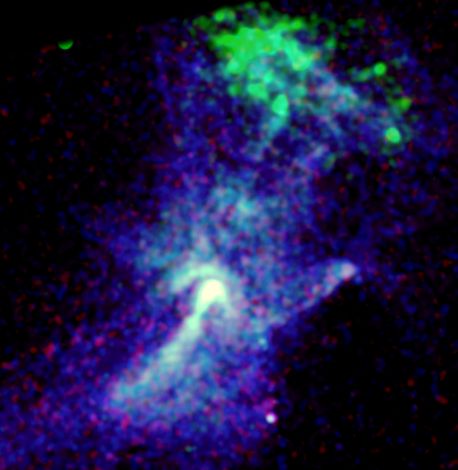Credit & Copyright: B. Gaensler et al.,
MIT,
NASA
Explanation:
A bizarre
stellar
corpse 19,000 light-years from Earth,
pulsar
PSR B1509-58
beckons from the small southern constellation
of Circinus.
Like its cousin at the heart of the Crab nebula,
the Circinus pulsar is a rapidly spinning, magnetized
neutron star.
Seen in this false-color
Chandra Observatory
image, the environment
surrounding this cosmic powerhouse glows in high energy x-rays.
The Circinus
pulsar itself, thought to generate more than
7 quadrillion
volts (7 followed by 15 zeros), lies within the knot of bright
emission near the center of the picture.
Stretching toward the bottom left,
x-ray
emission traces a
jet of particles almost 20 light-years long
that seems to arise from the pulsar's south pole,
while the arc of bright emission
above the central knot is likely a shockwave produced by particles
driven from the pulsar's equator.
Near the top of the picture, lower energy x-ray emission shown in green
is from gas shock-heated to millions of degrees Celsius.
The shocked gas was produced by debris
blasted out from
the stellar explosion that
created the Circinus pulsar.
1999 2000 2001 2002 2003 2004 2005 2006 2007 2008 2009 2010 2011 2012 2013 2014 2015 2016 2017 2018 2019 2020 2021 2022 2023 2024 2025 |
Январь Февраль Март Апрель Май Июнь Июль Август Сентябрь Октябрь Ноябрь Декабрь |
NASA Web Site Statements, Warnings, and Disclaimers
NASA Official: Jay Norris. Specific rights apply.
A service of: LHEA at NASA / GSFC
& Michigan Tech. U.
|
Публикации с ключевыми словами:
нейтронные звезды - neutron star - pulsar - Пульсар - рентгеновское излучение
Публикации со словами: нейтронные звезды - neutron star - pulsar - Пульсар - рентгеновское излучение | |
См. также:
Все публикации на ту же тему >> | |
